You are using an out of date browser. It may not display this or other websites correctly.
You should upgrade or use an alternative browser.
You should upgrade or use an alternative browser.
Reviews by johnchpark
Filters
Show only:
Loading…
johnchpark
Head-Fier
Pros: Good DSP tuning
Cons: No L/R labeling
Hissing
Uncomfortable Fit
Annoying Voice Guidance
Hissing
Uncomfortable Fit
Annoying Voice Guidance
At $200, the Alice is one of the more expensive TWS earbuds to come out of China. At that price, it should outperform established brands like Samsung or Apple, at least in sound, if not also the software.
The good thing is that Alice’s DSP tuning is great. In the Apple app store, Moondrop’s LINK app provides firmware updates and DSP tuning selections. There’s really only three tuning presets that are good: the Moondrop Target, In-Ear Target, and PEQ Default. The other tuning presets are garbage.
Connecting to iPhone bluetooth is seamless and much more convenient than other Chinese TWS earbuds. The Alice automatically connects to bluetooth when you take them out of the case and turns off when you put them back in the case. Previous ChiFi TWS earbuds were a bit more finicky to connect and disconnect.
The Pros end here.
Now for the cons:
1. The earpieces don’t have Left / Right indicators!! The earpieces look near identical and are shaped almost identically, so it’s really really difficult to figure out which side is L or R. You basically have to play a song and double tap on each earpiece to see if it skips forward or back, and then know that it is left or right. It’s shape isnt like typical earbuds, so you can’t tell just by the shape.
2. The shape is horrendous for ergonomics. In an era when every other manufacturer is going for smaller earbuds, Moondrop has chosen to go bigger. Their suggested wear instructions has you wearing the earpieces sticking out over the bottom of your earlobe. But it’s just a terrible wearing experience and it is completely insecure. There is no way you can exercise with these on. It looks funky sticking out of your ear, like a bluetooth earpiece from the early 2000’s. Plus, it feels uncomfortable and it falls out easily.
3. It HISSES LOUDLY. Whenever sound is playing out of the Alice, the driver has significant hiss. The hiss turns off when no media is playing. It hisses loudly enough to be audible even over music. Moondrop needed to have upped the impedance of the driver, but they didn’t, and it’s now way too sensitive.
4. Annoying voice guidance. I guess the person speaking to you is supposed to be Alice. But her voice and accent is just annoying. It’s a high-pitched, STRONG Japanese/Chinese accented girl’s voice. (I am Asian, so not being racist here). I guess Moondrop tried to go for an anime voice, but it’s not executed tastefully. Every time you turn it on, connect/disconnect, etc, you get the annoying voice guidance. I wish at least there was a way to disable voice guidance.
5. “VDSF+” doesn’t do anything really. I think it is Moondrop’s form of surround virtual sound, but it really doesn’t change the sound very much.
At the end of the day, if Alice was $100, it might make the product worthwhile. But at $200, I could never recommend Alice over Apple’s or Samsung’s TWS. Alice sounds good with DSP, but it hisses so much that it almost negates any positive thing I could say about the sound. Plus it fits terribly.
Oh one more thing. Their anime box image/design came off to me as distasteful, and borderline inappropriate. For one thing, i imagine a customer who paid $200 for a wireless earbud would want a more professional unboxing experience. But besides that, it’s just weird to see a commercial product with such a sexualized image stamped all over the box and leaflets. And that’s not even considering how young the girl looks. But I guess this isn’t Moondrop’s first strike at this sort of thing
Edit: i took it apart to see if there was any room to add some resistors to reduce to hiss. After modifying driver impedance, I came to the conclusion the hiss isn't from driver sensitivity, but from the chipset or some other electrical component.
The good thing is that Alice’s DSP tuning is great. In the Apple app store, Moondrop’s LINK app provides firmware updates and DSP tuning selections. There’s really only three tuning presets that are good: the Moondrop Target, In-Ear Target, and PEQ Default. The other tuning presets are garbage.
Connecting to iPhone bluetooth is seamless and much more convenient than other Chinese TWS earbuds. The Alice automatically connects to bluetooth when you take them out of the case and turns off when you put them back in the case. Previous ChiFi TWS earbuds were a bit more finicky to connect and disconnect.
The Pros end here.
Now for the cons:
1. The earpieces don’t have Left / Right indicators!! The earpieces look near identical and are shaped almost identically, so it’s really really difficult to figure out which side is L or R. You basically have to play a song and double tap on each earpiece to see if it skips forward or back, and then know that it is left or right. It’s shape isnt like typical earbuds, so you can’t tell just by the shape.
2. The shape is horrendous for ergonomics. In an era when every other manufacturer is going for smaller earbuds, Moondrop has chosen to go bigger. Their suggested wear instructions has you wearing the earpieces sticking out over the bottom of your earlobe. But it’s just a terrible wearing experience and it is completely insecure. There is no way you can exercise with these on. It looks funky sticking out of your ear, like a bluetooth earpiece from the early 2000’s. Plus, it feels uncomfortable and it falls out easily.
3. It HISSES LOUDLY. Whenever sound is playing out of the Alice, the driver has significant hiss. The hiss turns off when no media is playing. It hisses loudly enough to be audible even over music. Moondrop needed to have upped the impedance of the driver, but they didn’t, and it’s now way too sensitive.
4. Annoying voice guidance. I guess the person speaking to you is supposed to be Alice. But her voice and accent is just annoying. It’s a high-pitched, STRONG Japanese/Chinese accented girl’s voice. (I am Asian, so not being racist here). I guess Moondrop tried to go for an anime voice, but it’s not executed tastefully. Every time you turn it on, connect/disconnect, etc, you get the annoying voice guidance. I wish at least there was a way to disable voice guidance.
5. “VDSF+” doesn’t do anything really. I think it is Moondrop’s form of surround virtual sound, but it really doesn’t change the sound very much.
At the end of the day, if Alice was $100, it might make the product worthwhile. But at $200, I could never recommend Alice over Apple’s or Samsung’s TWS. Alice sounds good with DSP, but it hisses so much that it almost negates any positive thing I could say about the sound. Plus it fits terribly.
Oh one more thing. Their anime box image/design came off to me as distasteful, and borderline inappropriate. For one thing, i imagine a customer who paid $200 for a wireless earbud would want a more professional unboxing experience. But besides that, it’s just weird to see a commercial product with such a sexualized image stamped all over the box and leaflets. And that’s not even considering how young the girl looks. But I guess this isn’t Moondrop’s first strike at this sort of thing
Edit: i took it apart to see if there was any room to add some resistors to reduce to hiss. After modifying driver impedance, I came to the conclusion the hiss isn't from driver sensitivity, but from the chipset or some other electrical component.
Attachments
Last edited:
Linus Jian
It's so funny that a review on a hifi forum doesn't talk about sound lol. I mean I'm not against covering all the other parts but you wrote all these paragraphs and didn't even mention the sound? That's ridiculous.
bassdad8
Sound would have been nice in this review. If you want an actual review of these TWS buds, head over here:
johnchpark
Head-Fier
Pros: Great analog-like texture that is unique from traditional BA, DD, or EST driver IEMs
Great resolution
Good tuning
Great imaging
Great resolution
Good tuning
Great imaging
Cons: 2kHz pinna is a bit peaky and makes sounds too forward
Note attack speeds are slower than BA drivers, but this attributes to its analog-like texture
Cable feels plastic-y and stiff
Note attack speeds are slower than BA drivers, but this attributes to its analog-like texture
Cable feels plastic-y and stiff
Disclaimer: I am an IEM engineer and am heavily involved in the industry. I have been involved in the tuning and engineering of numerous IEM’s from numerous different popular IEM brands. I did not purchase the GL-AMT16, and tested it as a distributor sample from the factory. I do not profit from any GoldPlanar sales.
I go through A LOT of IEMs every year, but I am hardly ever bothered to write a review.
Furthermore, I considered most of GoldPlanar's previous headphones to be flops.
However, the GoldPlanar GL-AMT16 ("AMT16" from here on out) was surprisingly pleasant enough to be deemed worth a review.
Packaging:
Put simply, this is one of the most extravagant unboxing experiences I have ever had, period. I have never seen an IEM packaging be this nice from any brand. Inside the cardboard box is a solid, genuine wooden case with a sliding lid. The insides are layered with velvet packing. As someone involved in the industry, I was jealous my own brands couldn't match this level of product presentation. The Pelican case is also a huge plus.


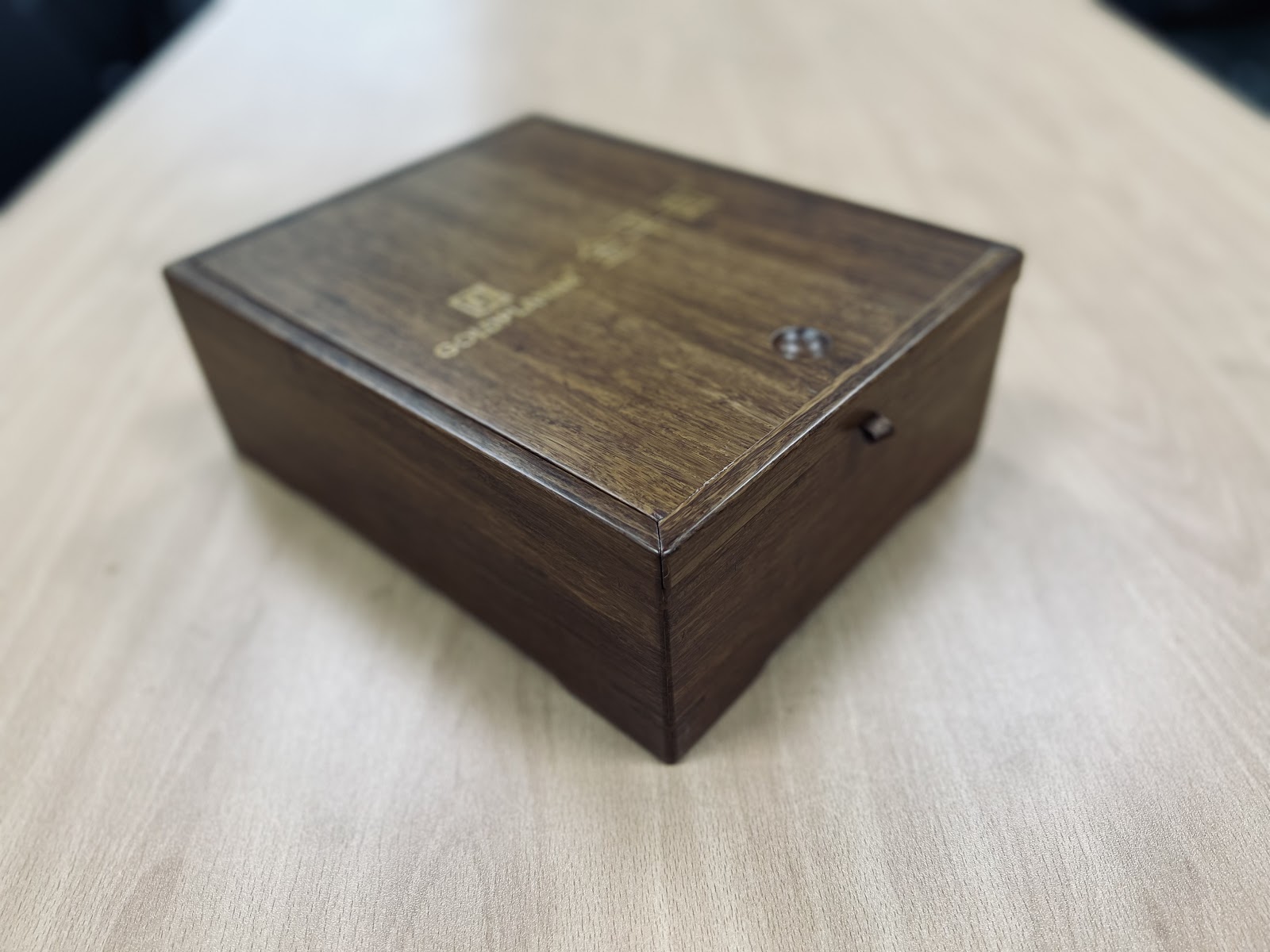
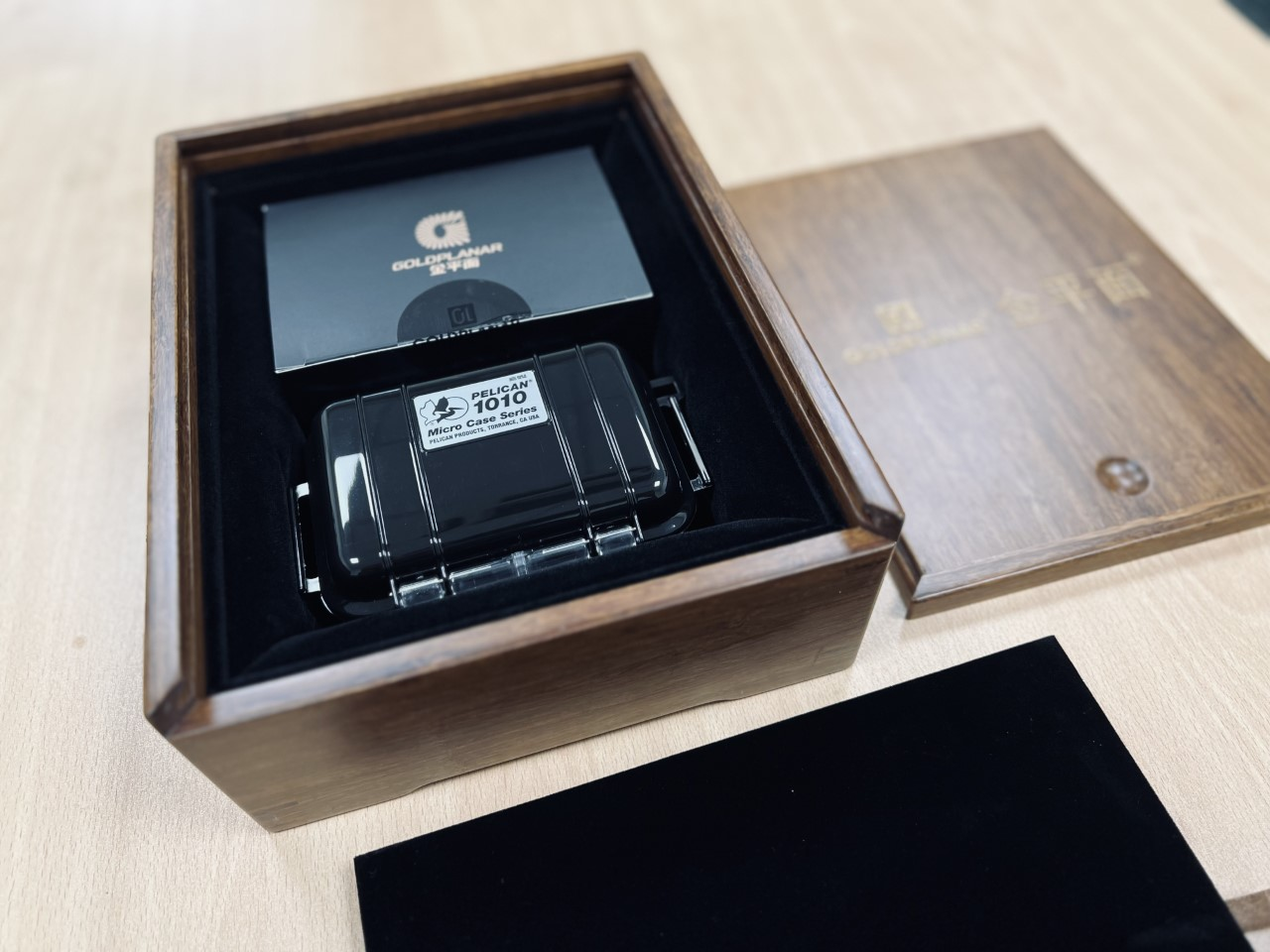
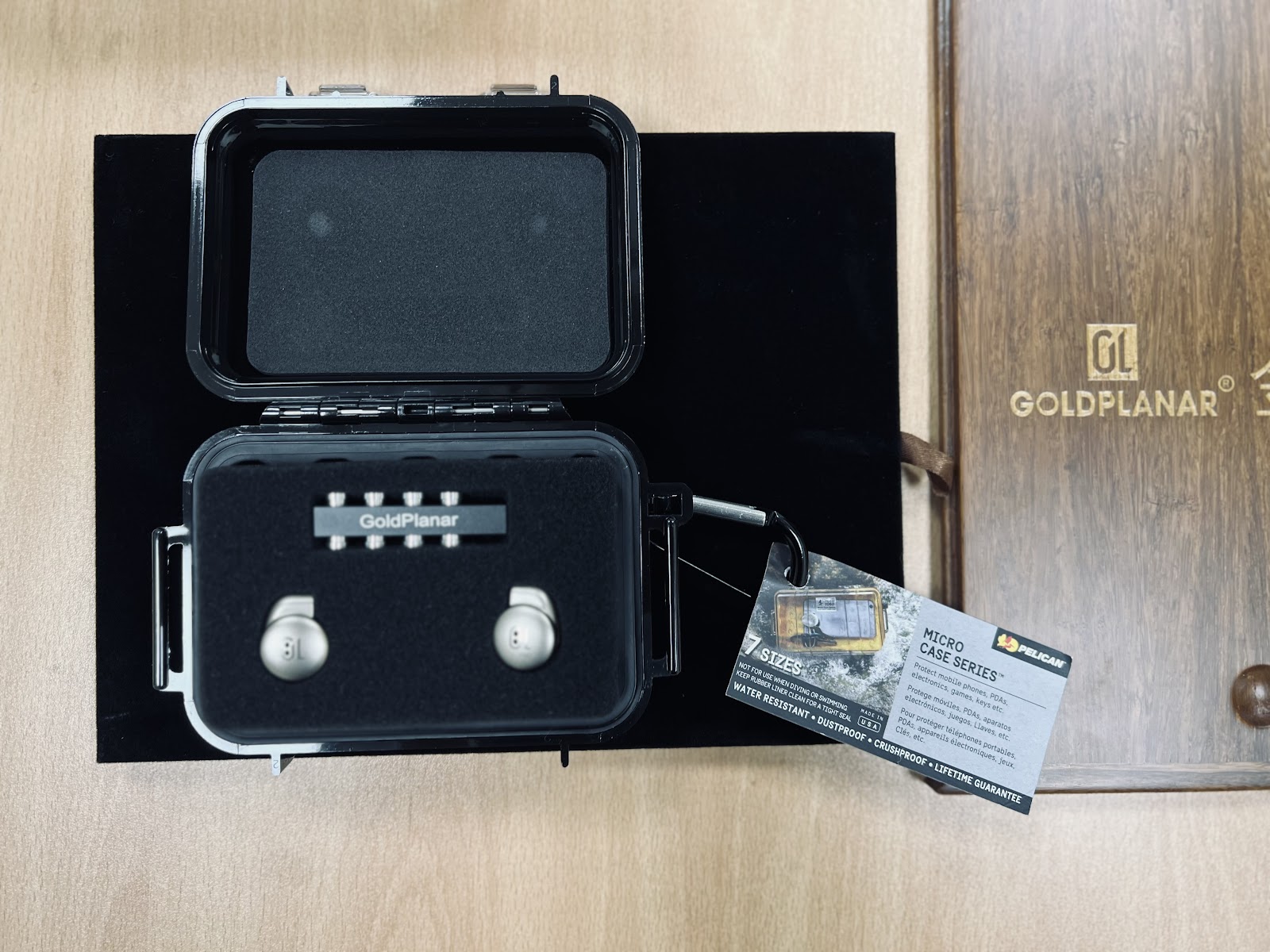
Cable:
The cable is one of those modular cable, similar to the Dunu or Thieaudio cables, with 3.5mm, 2.5mm, and 4.4mm connectors. The cable is an 8-core with 6 strands of copper and 2 strands of gold plated copper cables. My only gripe is that the cable feels a bit plastic-y and stiff, especially the ear hook.
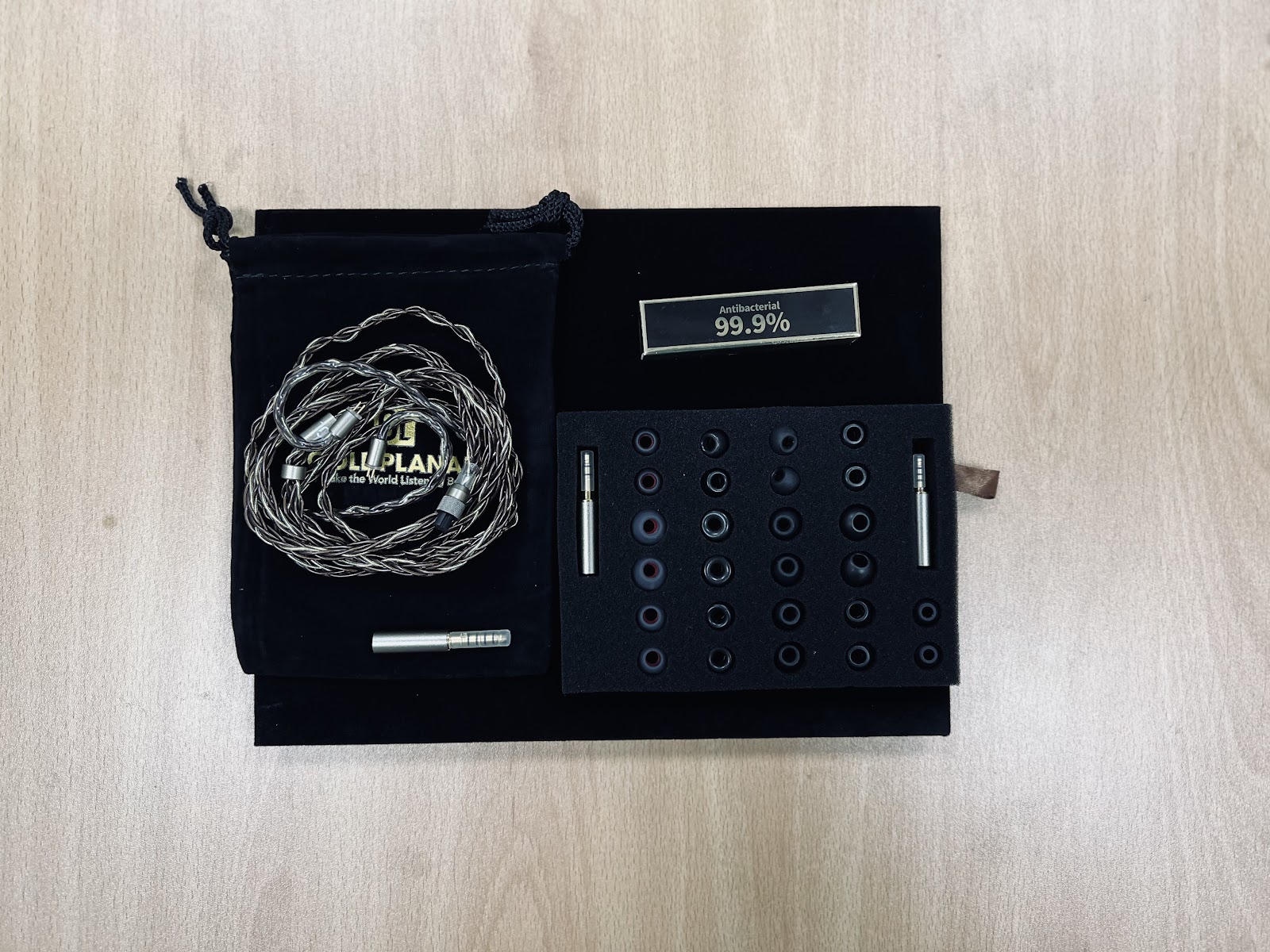
Fit:
The AMT16 isn’t too big and fits perfectly in my ears. It’s relatively slim so it doesn’t stick out obnoxiously either. It’s a really comfortable and slick fit and look.
Nozzles:
The AMT16 comes with five different nozzles. As an IEM engineer, I was really excited to see what they did with their nozzles. Normally, IEMs with exchangeable screw-on nozzles change the sound using different types of dampening filters. However, the AMT16 nozzles don’t have any dampening filters. Instead, they change the treble frequency by adjusting the nozzle diameters. Nozzle diameter on frequency changes is a fundamental component of IEM tuning, but you hardly ever see it utilized as an active way for users to adjust the tuning. It’s incredibly clever, and effective, as you can see by the frequency measurements.
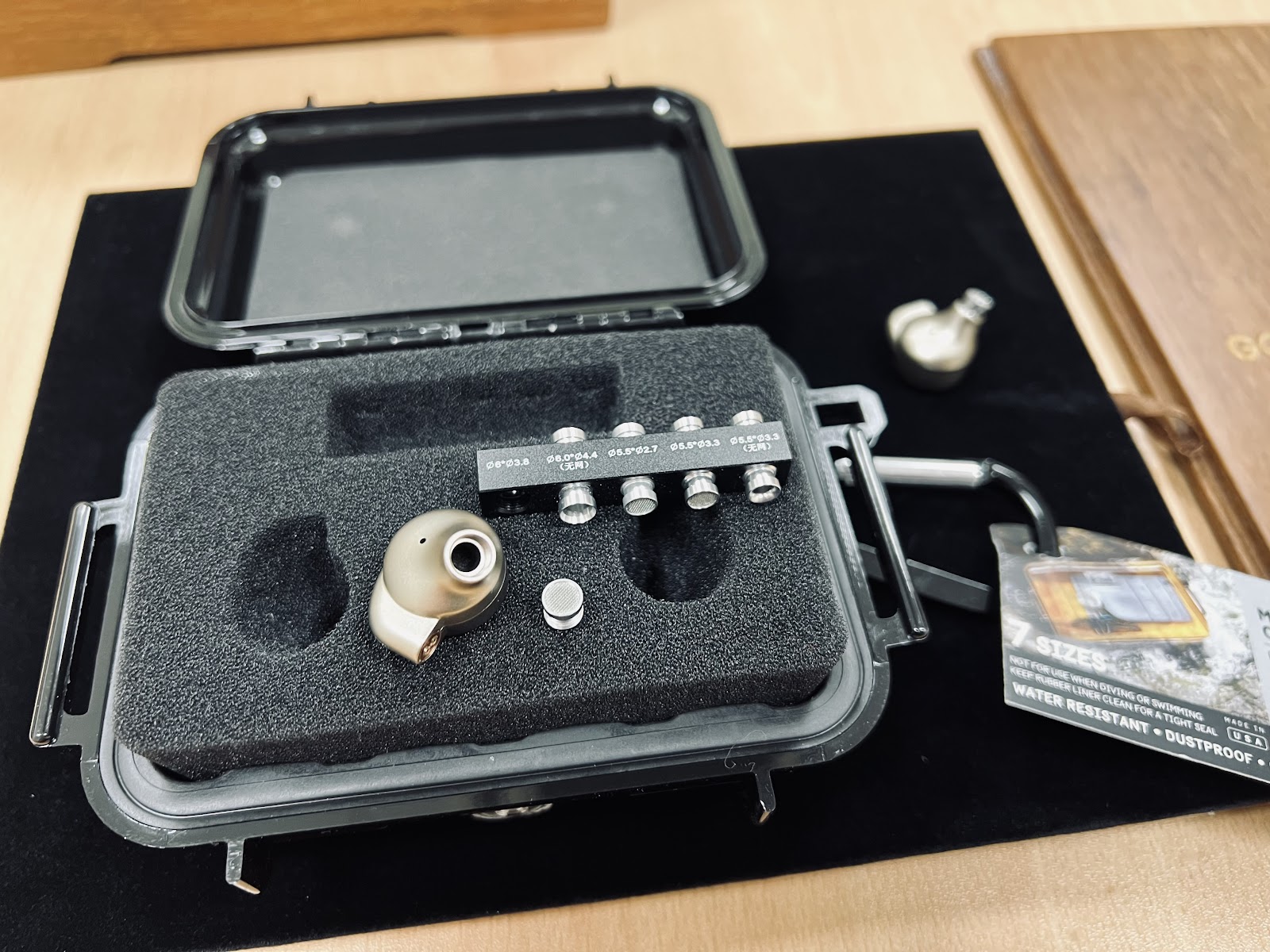

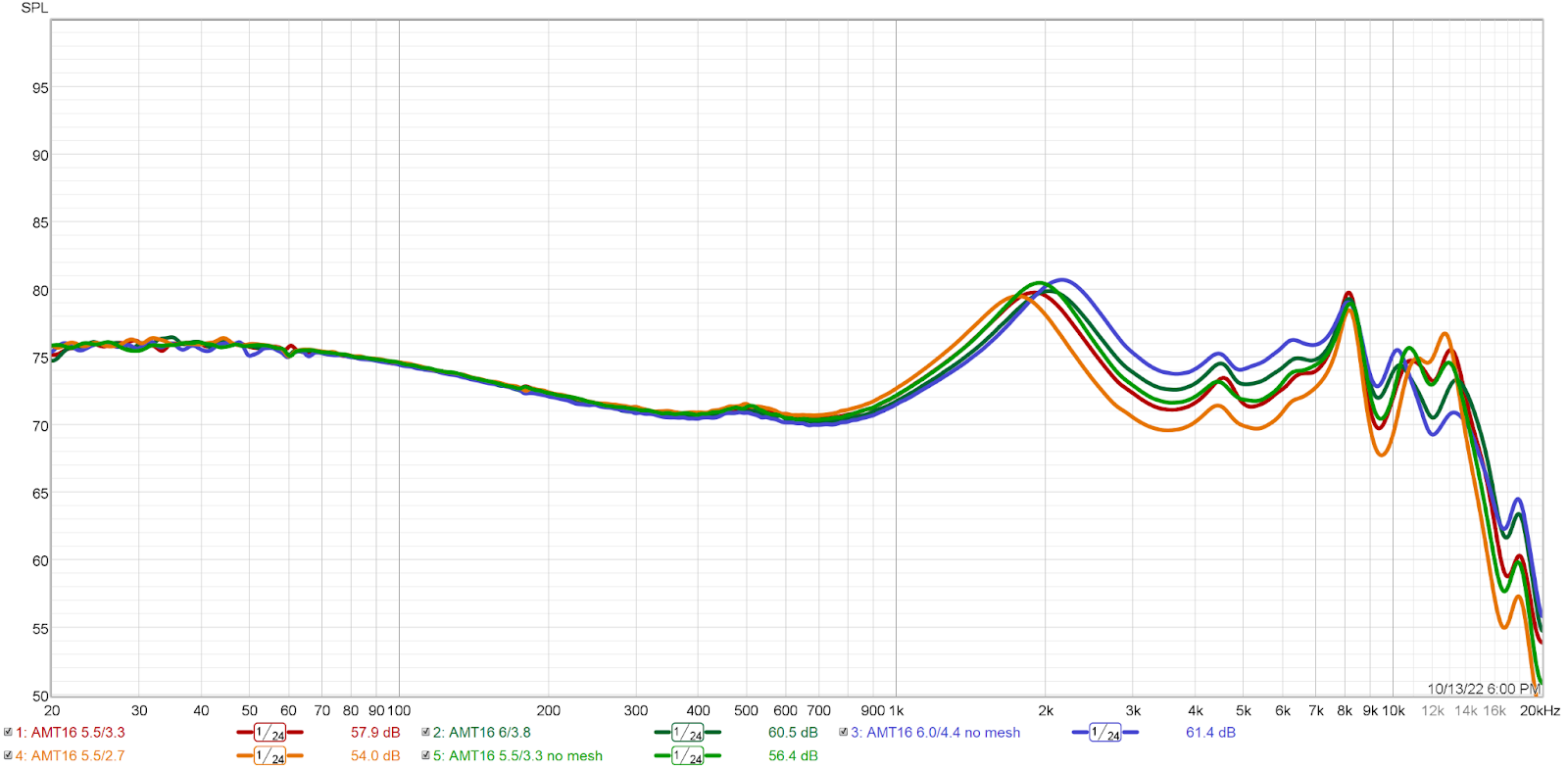
In short, the nozzle diameters (indicated on the nozzle holder) change the 1kHz ~ 15kHz range up to 5dB. It’s not a gimmick, and this is classical knowledge utilized innovatively. A huge applause to the GoldPlanar team.
Sound:
As an IEM engineer, I believe the IEM industry is at a stagnant point, mostly due to the lack of new driver types. From a technicalities point of view, there is only so much you can do with typical BA, DD, or even EST drivers to make them really stand out. Most of the successful “traditional” IEMs lately were great mostly due to their tuning strategies rather than their technicalities compared to what's already out there. However, the AMT driver that the AM16 utilizes may be a fresh revitalization for the IEM industry.
I usually will tear apart such IEMs I receive to see the drivers, but I like the AMT16 so much that I will keep it intact. But what I can tell is that it seems to be the real deal and not a gimmick. The sound definitely has an analog-like quality, reminiscent of ribbon transducers. The texture sounds very relaxed, as if the driver is putting out sound with ease. Directly compared to an all BA IEM such as the Thieaudio V16, the BA drivers sound plastic-y and strained while the AMT drivers sound much more relaxed. In fact, this is probably because the BA drivers have faster transients and attacks compared to the AMT. Notes on typical BA or Tribrid IEMs end up sounding tighter while the AMT16 feels more laidback. For this reason, it's a little hard to directly compare perceived resolution. While the AMT16 definitely has great texture and smoothness, the attacks definitely feel blunted compared to the transients of BA drivers, which makes the AMT16 feel hazy in the notes. But overall, I would say it's as resolving as any of my other TOPL IEMs, albeit the differences in attack and decay speeds.
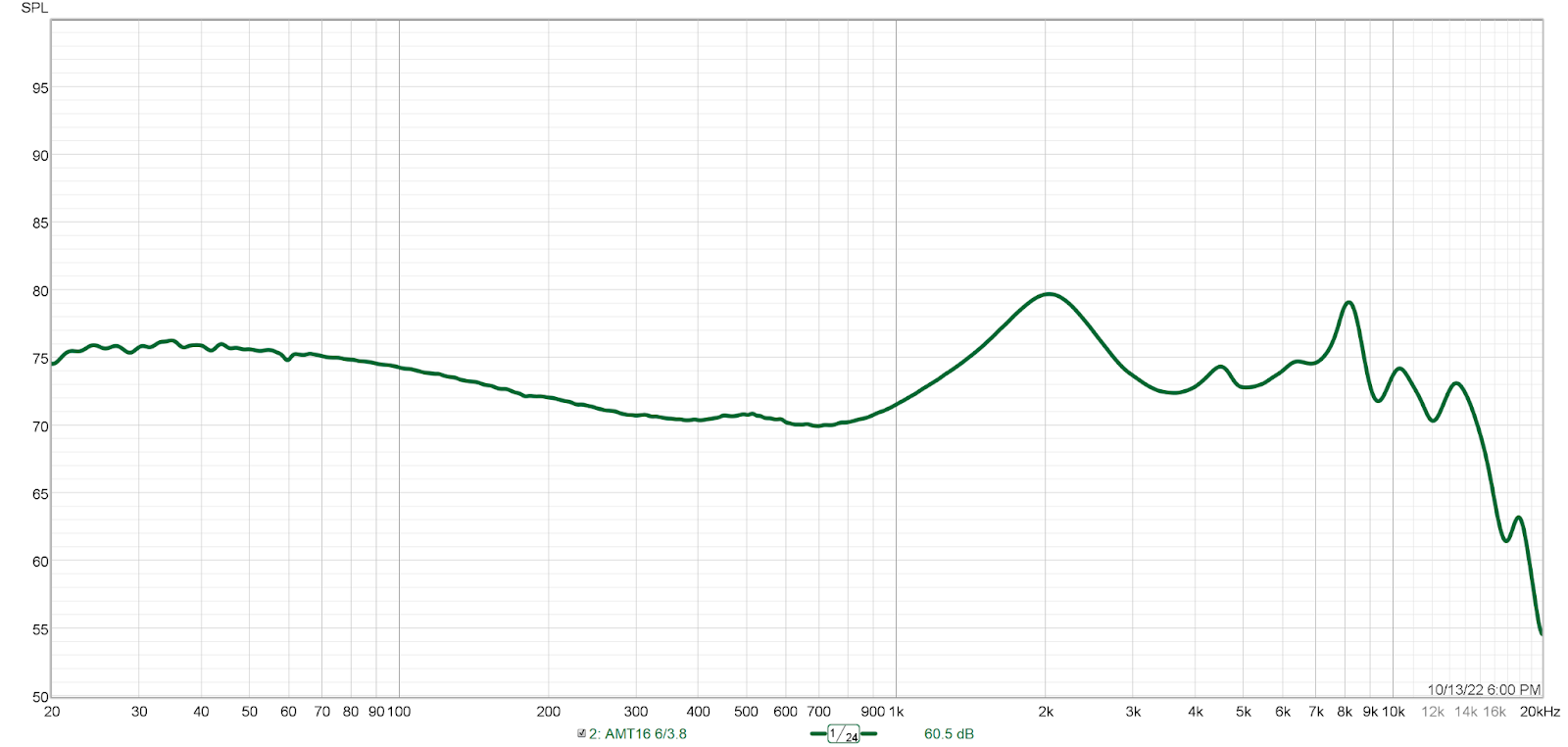
The tuning is surprisingly good for a new driver type (I was half expecting it to be a complete tuning mess). I don’t have any significant complaints about the tuning except that it does have a very sharp 2kHz pinna peak, which is audible. It makes a lot of instruments and voices very forward and slightly honky. Putting a black dampening filter sticker (like those found on Moondrop or Tanchjim products) does reduce this pinna, but also does so too much. The bass doesn’t slam, which is also evident by the frequency graph, but it is quite punchy and well balanced. I would say the mids on the AMT16 are its highlight, which are very rich and lush, and have a great analog quality to them. The good treble extension also provides a nice airiness to the overall sound and helps with the resolution. Imaging and depth is excellent with most tracks. Jazz was simply a delight to listen to with these. Brushes on drums never sounded so good.

(AMT16 with a Tanchjim Dampening Filter on the nozzle)
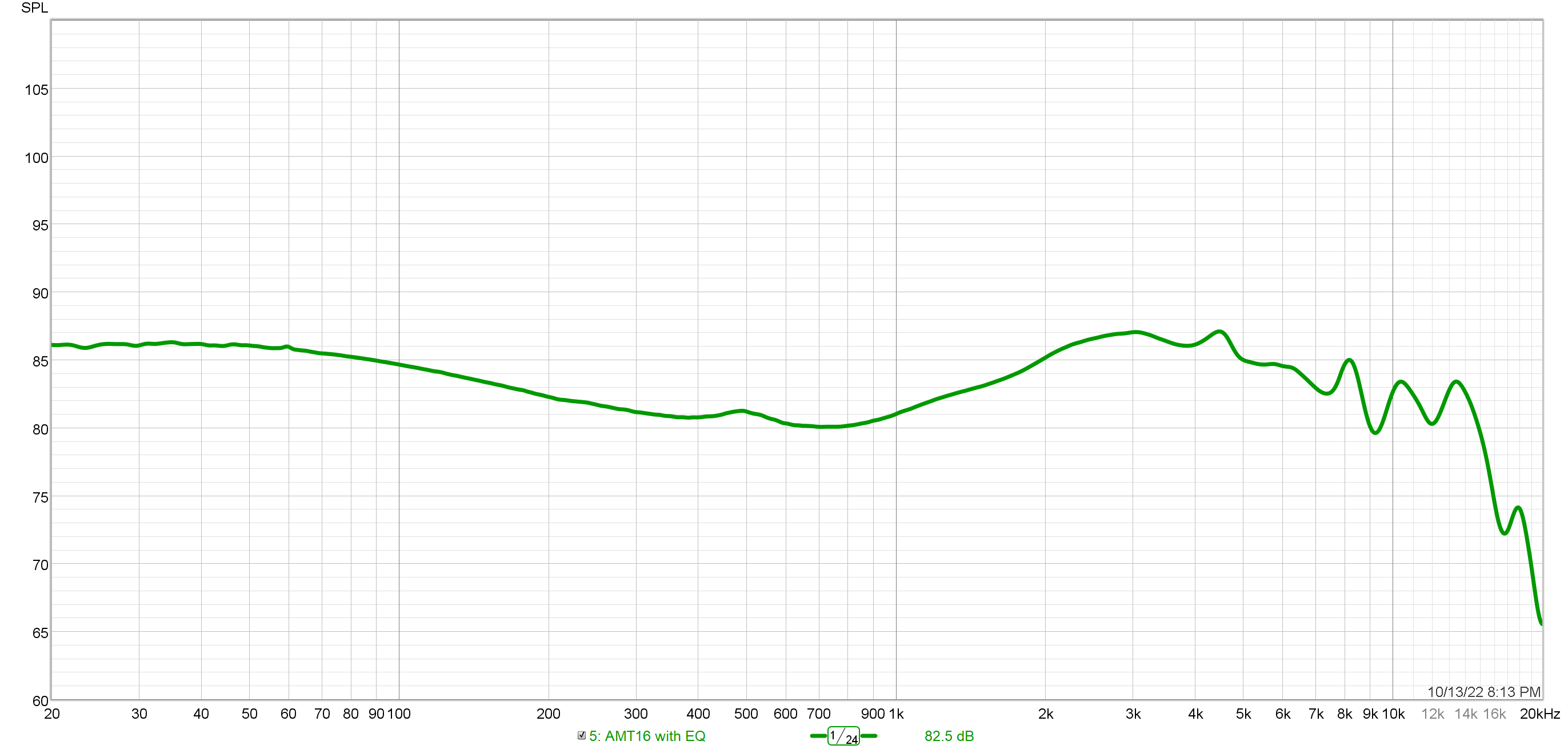
(AMT16 with EQ; light adjustments at 2kHz, 3.1kHz, 5kHz, and 8kHz)
Overall, the tuning of the AMT16 is acceptable, but not perfect to my ears. It does need some physical adjustments or EQ to reduce the 2kHz pinna. But apart from that, the AMT driver utilized definitely gives a unique textural quality that is refreshingly new in the IEM industry. It’s truly an analog-like sound that stands out from the typical BA, EST, or even planar timbre. Rather than simply "the best single IEM out there", I believe the AMT16 stands out as a technological innovation that is worth its place in a collection. Because of its textural characteristics, it's not suitable for stage or studio use (plus, I don't think it will handle drops well due to the driver). Instead, the AMT16 is perfect for audio enthusiasts who have other IEMs and want a product that is strictly unique and refreshing. I’m sure in the coming future, we will see more of these AMT drivers used by other manufacturers (like what happened with IEM planar drivers), and I’m really excited to see if this will turn into a new era for the IEM industry.
I go through A LOT of IEMs every year, but I am hardly ever bothered to write a review.
Furthermore, I considered most of GoldPlanar's previous headphones to be flops.
However, the GoldPlanar GL-AMT16 ("AMT16" from here on out) was surprisingly pleasant enough to be deemed worth a review.
Packaging:
Put simply, this is one of the most extravagant unboxing experiences I have ever had, period. I have never seen an IEM packaging be this nice from any brand. Inside the cardboard box is a solid, genuine wooden case with a sliding lid. The insides are layered with velvet packing. As someone involved in the industry, I was jealous my own brands couldn't match this level of product presentation. The Pelican case is also a huge plus.

Cable:
The cable is one of those modular cable, similar to the Dunu or Thieaudio cables, with 3.5mm, 2.5mm, and 4.4mm connectors. The cable is an 8-core with 6 strands of copper and 2 strands of gold plated copper cables. My only gripe is that the cable feels a bit plastic-y and stiff, especially the ear hook.
Fit:
The AMT16 isn’t too big and fits perfectly in my ears. It’s relatively slim so it doesn’t stick out obnoxiously either. It’s a really comfortable and slick fit and look.
Nozzles:
The AMT16 comes with five different nozzles. As an IEM engineer, I was really excited to see what they did with their nozzles. Normally, IEMs with exchangeable screw-on nozzles change the sound using different types of dampening filters. However, the AMT16 nozzles don’t have any dampening filters. Instead, they change the treble frequency by adjusting the nozzle diameters. Nozzle diameter on frequency changes is a fundamental component of IEM tuning, but you hardly ever see it utilized as an active way for users to adjust the tuning. It’s incredibly clever, and effective, as you can see by the frequency measurements.
In short, the nozzle diameters (indicated on the nozzle holder) change the 1kHz ~ 15kHz range up to 5dB. It’s not a gimmick, and this is classical knowledge utilized innovatively. A huge applause to the GoldPlanar team.
Sound:
As an IEM engineer, I believe the IEM industry is at a stagnant point, mostly due to the lack of new driver types. From a technicalities point of view, there is only so much you can do with typical BA, DD, or even EST drivers to make them really stand out. Most of the successful “traditional” IEMs lately were great mostly due to their tuning strategies rather than their technicalities compared to what's already out there. However, the AMT driver that the AM16 utilizes may be a fresh revitalization for the IEM industry.
I usually will tear apart such IEMs I receive to see the drivers, but I like the AMT16 so much that I will keep it intact. But what I can tell is that it seems to be the real deal and not a gimmick. The sound definitely has an analog-like quality, reminiscent of ribbon transducers. The texture sounds very relaxed, as if the driver is putting out sound with ease. Directly compared to an all BA IEM such as the Thieaudio V16, the BA drivers sound plastic-y and strained while the AMT drivers sound much more relaxed. In fact, this is probably because the BA drivers have faster transients and attacks compared to the AMT. Notes on typical BA or Tribrid IEMs end up sounding tighter while the AMT16 feels more laidback. For this reason, it's a little hard to directly compare perceived resolution. While the AMT16 definitely has great texture and smoothness, the attacks definitely feel blunted compared to the transients of BA drivers, which makes the AMT16 feel hazy in the notes. But overall, I would say it's as resolving as any of my other TOPL IEMs, albeit the differences in attack and decay speeds.
The tuning is surprisingly good for a new driver type (I was half expecting it to be a complete tuning mess). I don’t have any significant complaints about the tuning except that it does have a very sharp 2kHz pinna peak, which is audible. It makes a lot of instruments and voices very forward and slightly honky. Putting a black dampening filter sticker (like those found on Moondrop or Tanchjim products) does reduce this pinna, but also does so too much. The bass doesn’t slam, which is also evident by the frequency graph, but it is quite punchy and well balanced. I would say the mids on the AMT16 are its highlight, which are very rich and lush, and have a great analog quality to them. The good treble extension also provides a nice airiness to the overall sound and helps with the resolution. Imaging and depth is excellent with most tracks. Jazz was simply a delight to listen to with these. Brushes on drums never sounded so good.

(AMT16 with a Tanchjim Dampening Filter on the nozzle)

(AMT16 with EQ; light adjustments at 2kHz, 3.1kHz, 5kHz, and 8kHz)
Overall, the tuning of the AMT16 is acceptable, but not perfect to my ears. It does need some physical adjustments or EQ to reduce the 2kHz pinna. But apart from that, the AMT driver utilized definitely gives a unique textural quality that is refreshingly new in the IEM industry. It’s truly an analog-like sound that stands out from the typical BA, EST, or even planar timbre. Rather than simply "the best single IEM out there", I believe the AMT16 stands out as a technological innovation that is worth its place in a collection. Because of its textural characteristics, it's not suitable for stage or studio use (plus, I don't think it will handle drops well due to the driver). Instead, the AMT16 is perfect for audio enthusiasts who have other IEMs and want a product that is strictly unique and refreshing. I’m sure in the coming future, we will see more of these AMT drivers used by other manufacturers (like what happened with IEM planar drivers), and I’m really excited to see if this will turn into a new era for the IEM industry.
Last edited:
o0genesis0o
Very nice to read a review from someone with engineering knowledge about IEM!
Bitsir
Can't wait for AMT & MEMs to ravage the IEM scene in the coming years. The diamond age of IEMs is yet to come.
Steranko
I got a pair of these today via recommendation from other people as well and boy are these good for the price. Don't use the stock cables and they are very impressive. Highly recommended to try out. You literally getting equivalent of uninhibited Obravo CU sound for a quarter of the price.
johnchpark
Head-Fier
The Fearless Audio S8Z features a coherent and a warm, yet balanced, tuning that is full and engaging to the listener. Its technical abilities also exceed that of its peers with excellent detail retrieval, resolution, and imaging. The S8Z is one of the best offerings that Fearless Audio has come up with, and perhaps the best monitor available in its relative class.
I will say this right off the bat. The new S8Z Fearless Audio cable (grey 8-core with metal connectors) is the worst cable I have ever experienced. The quality of the cable is amazing. The sound is also great. But they chose to use some kind of solid iron for the Y-splitter and the chin slider, and the cable is HEAVY. It just drags down and tugs on your ears like nothing before. It looks nice and feels nice in the hands, but in terms of actual practicality, it is the worst decision they could have chosen.
Now, to the important part. Sound.
The S8Z is a mild-V shaped tuning (elevated bass and trebles), that builds from the skeleton of its predecessor, the S8F. However, the low and low-mids are slightly cut back, making the entire sound a little more balanced and lean, which is a good thing considering the S8F was a solid V-shaped tuning. The bass consequently does not have the level of impact as the S8F, but it is still relatively abundant, and is a punchy and fast type of hit. It feels tighter and cleaner, and helps to make the S8Z a bit more technically adept than its predecessor.
With its mild V-tuning, the mids are on the warmer side. It’s not as quite articulate as I would want, but vocals still have a nice body and texture to them. The S8Z really is great for both male and female vocals as they sound full, warm, and clear. Despite leaning V, I have not had any instances where the vocals felt lacking, behind, or overlapping with other instruments. The warmer mids give the S8Z a fuller sound and some girth to instruments and vocals, making it a great choice for musicians for stage monitoring. However, as with all V-shaped monitors, the warmth also means cutting against overall tightness, and while the S8Z can’t be described as sloppy or mushy, it is not as neutral as something like the S6Pro.
The treble on the S8Z is also an evolution from the S8F. Fearless has cut back slightly on the 3-4k area that made the S8F sometimes a bit too hot. The S8Z has a more comfortable treble than its predecessor, but is still incredibly technical. There does not seem to be any apparent odd peaks or dips, making the treble quite coherent all throughout. And although the treble extends nicely, this coherency keeps the S8Z from sounding harsh or too bright. I believe it’s at the perfect balance between technicality and listening comfort. The S8Z has a sharper 1-2k rise that makes vocals and snares tight and a clean transition from lower trebles to mid trebles, giving vocals a nice and crispy bite. Vocal presence is also nice, indicating the mid treble range is also quite smooth. Cymbals have quite a nice timbre to them and don’t have any weird shrills or brilliance. Overall, the treble was tuned with just enough balance to sustain the warmer low and low-mids and all the while keep the sound articulate and technical.
In technicalities, Fearless has opted to go with a more intimate soundstage, however, there is still enough air to keep it from sounding damp or cluttered. Instrument separation and layering is also not bad, with nothing seemingly overlapping or getting covered up. But a little more leeway may have helped to clean up the low-mids. Although not the widest, imaging is still really nice and accurate. Resolution is pretty great. It's at, if not better, than peers such as the Moondrop S8, but it's not quite at the level of legendary IEM's such as the Sony Z1R or Vision Ears VE8, or even the Hidition Viento.
Overall, the S8Z pumps out a fun, full, and engaging sound that is quite technically adept. It’s a signature that is easy for anyone to enjoy, and sits at the top of the competition among its relative peers.
johnchpark
Head-Fier

From what I know, Thieaudio is a manufacturing brand under Linsoul Audio.
Linsoul composes a team for each new project, bringing together engineers from different manufacturers to lead the product development and production. This is how the Thieaudio Phantom planar magnetic headphones came to be last year. This time, with the aim of making a lineup of In Ear Monitors, Thieaudio started the Voyager series, which will have 3 IEM’s, all in different price ranges. Voyager 3 (3BA, $100-200), Voyager 9 (8BA+1DD, $500-600 ? [This is still in development phase I hear]), and Voyager 14 (14BA, $1000).
I received the Voyager 14 as a loaner for testing and tour in South Korea, and will have to return it back to Linsoul afterwards.


Build Quality
I’ll brief in describing the IEM itself.
It’s well built. The resin feels solid and durable. It is half full with resin, and half hollow. This is probably due to the vented Sonion bass drivers, which is also why there is a vent in the shell itself. I got a wooden faceplate, which looks really nice. The shell is clear, and it looks like there aren't any kinks in the tubing or wiring. The size is on the bigger side, which makes sense with the number of drivers inside.

Switches
The Voyager 14 comes with two switches, one for the low-mids, and one for the upper trebles.
Both switches (1,1) up gives it a definite V-shape that pushes up both mid-bass and treble. While it’s great for some genres like rock and metal, it’s not my cup of tea (I don’t like V-shape tunings in general).
Low up, High down (1,0) pushes the mid-bass up and just makes the tuning sound sluggish, a bit dark, and mellow. I’m almost never on this setting.
Low Down, High up (0,1) elevates the upper trebles. It’s not necessarily more of a mid-treble bump as it is a high treble, so it will affect the atmosphere, brilliance, and soundstage. This is also a decent setting if you like airy atmospheres or something leaner. It doesn’t necessarily make the tuning brighter; leaner is a better term. This is probably also the most technical setting.
Low Down, High Down (0,0) is a tuning I also like. It’s quite balanced among the other settings, and I love the texture of vocals on this setting. However, it can also give a slightly boxy/nasal tone. I’m almost always on 0,0 or 0,1 settings.

Sound
I will write about the sound in the (0,1) setting.
In general, even with all of the switches down, the tuning leans towards a slight V. Not a severe, or even mild V, but a slight V. This gives it a bit of warmth, but not enough so that it hinders on technicality or the overall balance. I would call the tuning balanced, but also musical. Perhaps somewhere between the Anole VX, Fibae 7, VE8, from memory.
Bass
The bass focuses on mid-bass rather than the sub-bass.
The bass is impactful and can definitely rumble, and in this regard, I will not even add the “for a BA” tag. It’s a strong bass, period. However, the quality of the bass is still like that of a typical BA. It’s not the fastest bass, and with the mid-bass emphasis, it can at times feel a little sluggish and spread especially on 1,1 or 1,0 settings, rather than tight like that of other driver types. It’s a deep and impactful bass, but decay is a bit on the slower side, and not the cleanest texture. The mid-bass emphasis makes bass guitar, tom-toms, and lower register keys sound really great. Kick drum is usually ok, but doesn’t have that super clean punchy texture like from a dynamic driver. Overall, the bass has a nice depth, and is quite solid.
Mids
The mids are on the warmer rather than neutral side. However, vocals are almost never behind (on the 0,0 setting. On the 1,1 or 1,0 setting, they can fall behind). One major strength of the Voyager 14 is the texture of the mids. They are truly rich and well-textured. Well recorded vocal tracks can sound so good, not just in terms of the tuning, but the timbre and texture of the sound. However, on the note of vocals, the Voyager 14 made the tuning decision to cut back on the upper vocal frequencies, which sometimes removes that “bite” and clarity/presence from vocals. This makes vocals sometimes a little hazy and less defined, but in return, it does make for smoother vocal finishes. Whether you like this or not will depend on your cup of tea. Do you want sharper vocals, or smoother vocals? For me personally, I would like a little bit more in the 5-6k area. The extent also depends on vocalist’s range itself. Additionally, it’s not that vocals feel positionally behind, but rather about the quality of the vocal finish itself. Apart from vocals, string instruments, particularly acoustic guitars and keys also have great texture and timbre. In classical music, strings, especially cello, violas, and lower register violins, sound fantastic (this is coming from a performing violist). In violins in the 0,1 setting, E-strings can come off as slightly sharp (probably due to the 1-2k characteristic of the iem) and is much smoother on 0,0 setting. Same with some woodwinds like oboe and clarinet. But other than that, orchestral pieces sound fantastic, particularly due to the soundstage and imaging of the Voyager 14. Texture and timbre. Delicious.
Treble
The extension of the trebles is really great. Every detail is there, but the treble is never harsh or piercing. It’s actually a very smooth treble, that has been well extended, which gives a great airy atmosphere and helps to widen the soundstage. Snare brushes and guitar strings have a nice shimmer to them. Cymbals in general are well balanced and never get in the way with too much brilliance. The one caveat to the treble is that there seems to be a slightly sharper rise on the 1-2k area, which can throw off the tonality from the near-perfect tonal balance of the entire set. This can sometimes make sounds like hand clapping or snare snaps and side-sticks too sharp for the mix. Certain female vocals (like Norah Jones for me) can feel a little too sharp because of this as well.
Overall in tuning, I find the tonal balance almost perfect. If I could, I would back down 1-2k by a little bit, and raise 5-6k by just a little bit, and it would be a perfectly satisfactory tuning for me. Moving the hill of the bass from the mid-bass to sub-bass by a little would also help to make the sound tighter. To me, its tonality is not as good as that of the Anole VX or the VE8, both of which I loved, but for half/third of their price, this is damn good.
Technical Aspects
In terms of technicalities, the Voyager 14 is also quite impressive. The 5-way crossover definitely is noticeable with fantastic instrument separation and layering. It really does shine so well in complex mixes and compositions. Even on the 1,1 setting where the mid-bass verges on hindering on vocals, the separation of the Voyager 14 saves it from any loss in the vocals. Imaging is also very accurate. Soundstage is spectacular, with plenty of air. It is definitely wider than the Anole VX, but the VX seemed to have a little more depth. Not as wide as Z1R though.

Conclusion
All in all, the Voyager 14 is an incredibly technical IEM that has an almost amazing tuning, but could use a few tweaks to make it perfect (in my opinion and preference). The Voyager 14 is definitely a new step up in the “Chi-Fi” market, and clearly steps up from the likes of the Moondrop A8/S8 and the Fearless Audio series. In this regard, the Voyager 14 is one of the few Chi-Fi items that I have tried that sits firmly and solidly in the “Hi-Fi” category (as opposed to “Mid-Fi”).
There are many so-called “Hi-Fi” IEM’s from Western big brands that I have tried and felt were just ‘meh’, and did not deserve the price they were asking for. The Voyager 14 is a clear distinction from the myriad of these kinds of monitors.
But the big question for me is whether the Voyager 14 can steps into the likes of “legendary” IEM’s. Does Voyager 14 fit into the category of the Z1R, VX, VE8, etc?
For me, while the Voyager 14 can definitely stand in the ring with such legends, it doesn’t quite defeat them. And a lot of this comes to the few kinks in the tuning, which I have described. However, the true prowess of the Voyager 14 is in regards to its price. It is anywhere between half and a fourth of the price of some of its worthy competitors, and while it may not win, it gets damn close, and that’s huge. For customers who are targeting these “legends”, and know exactly why they want them, the Voyager 14 may miss the mark. However, for everyone else who do not have that one reason for getting a Z1R or VE8 or what not, the Voyager 14 may be the perfect balance between price and performance. This is particularly true considering that a lot of the top brand name mid-tier products (which end up in the $1000-2000 range) don’t measure up to the Voyager 14, in my opinion.



Last edited:









Even super review found a lot of bugs. If I am not wrong moondrop uses their own vtuber for the voice prompt?
Its quite an expensive tws. Would have been nice if it was more polished.